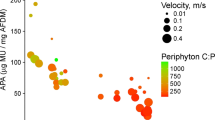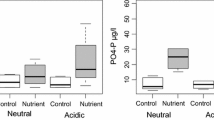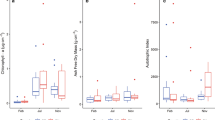Abstract
We sampled periphyton communities in a highly productive stream to characterize how longitudinal changes in watershed geology and land use affect periphyton nutrient status and elemental composition. Nutrient status was evaluated from measures of periphyton nutrient composition (carbon, nitrogen, and phosphorus), stable isotope signatures (δ15N and δ13C), and the response of periphyton to experimental enrichment with nitrogen. Biomass and nutrient content increased dramatically from the headwaters to downstream, while tissue nutrient ratios (C:P and C:N) were more consistent and did not indicate strong N- or P-limitation. Nitrogen enrichment experiments did not exhibit a consistent response upstream or downstream, and periphyton C:N:P stoichiometry showed no significant response to N-enrichment. Absolute densities of periphyton N were 5- to 90-fold greater than the overlying N concentrations in stream water (159- to 353-fold greater for P), and the δ15N signal indicates downstream enrichment from likely watershed sources (urban and agriculture land-use). These results suggest that periphyton in Spring Creek are not N-limited and store large quantities of both N and P, which in turn can be transported downstream during high flow events.




Similar content being viewed by others
References
American Public Health Association (APHA), 1995. Standard Methods for the Examination of Water and Wastewater: Including Bottom Sediments and Sludges, 20th edn. American Public Health Association, New York.
Biggs, B. J. F., 1987. Effects of sample storage and mechanical blending on the quantitative analysis of river periphyton. Freshwater Biology 18: 197–203.
Biggs, B. J. F., 2000. Eutrophication of streams and rivers: dissolved nutrient-chlorophyll relationships for benthic algae. Journal of the North American Benthological Society 19: 17–31.
Bothwell, M. L., 1985. Phosphorus limitation of lotic periphyton growth rates - an intersite comparison using continuous-flow troughs (Thompson river system, British Columbia). Limnology and Oceanography 30: 527–542.
Box, G. E. P. & D. R. Cox, 1964. An analysis of transformations. Journal of the Royal Statistical Society, Series B-Statistical Methodology 26: 211–252.
Carrick, H. J., F. J. Aldridge & C. L. Schelske, 1993. Wind influences phytoplankton biomass and composition in a shallow, productive lake. Limnology and Oceanography 38: 1179–1192.
Chang, H. & T. N. Carlson, 2005. Water quality during winter storm events in Spring Creek, Pennsylvania USA. Hydrobiologia 544: 321–332.
Chételat, J. & F. R. Pick, 2001. Temporal variability of water chemistry in flowing waters of the northeastern United States: does river size matter? Journal of the North American Benthological Society 20: 331–346.
Cross, W. F., J. P. Benstead, P. C. Frost & S. A. Thomas, 2005. Ecological stoichiometry in freshwater benthic systems: recent progress and perspectives. Freshwater Biology 50: 1895–1912.
Dodds, W. K., A. J. Lopez, W. B. Bowden, S. Gregory, N. B. Grimm, S. K. Hamilton, A. E. Hershey, E. Marti, W. H. McDowell, J. L. Meyer, D. Morrall, P. J. Mulholland, B. J. Peterson, J. L. Tank, H. M. Valett, J. R. Webster & W. Wollheim, 2002a. N uptake as a function of concentration in streams. Journal of the North American Benthological Society 21: 206–220.
Dodds, W. K., V. H. Smith & K. Lohman, 2002b. Nitrogen and phosphorus relationships to benthic algal biomass in temperate streams. Canadian Journal of Fisheries and Aquatic Sciences 59: 865–874.
Droop, M. R., 1973. Some thoughts on nutrient limitation in algae. Journal of Phycology 9: 264–272.
Elser, J. J., D. R. Dobberfuhl, N. A. MacKay & J. H. Schampel, 1996. Organism size, life history, and N:P stoichiometry. Bioscience 49: 674–684.
Elser, J. J., W. F. Fagan, R. F. Denno, D. R. Dobberfuhl, A. Folarin, A. Huberty, S. Interlandi, S. S. Kilham, E. McCauley, K. L. Schulz, E. H. Siemann & R. W. Sterner, 2000. Nutritional constraints in terrestrial and freshwater food webs. Nature 408: 578–580.
Elser, J. J., K. Acharya, M. Kyle, J. Cotner, W. Makino, T. Markow, T. Watts, S. Hobbie, W. Fagan, J. Schade, J. Hood & R. W. Sterner, 2003. Growth rate-stoichiometry couplings in diverse biota. Ecology Letters 6: 936–943.
Fairchild, G. W., R. L. Lowe & W. B. Richardson, 1985. Algal periphyton growth on nutrient-diffusing substrates - an in situ bioassay. Ecology 66: 465–472.
Finlay, J. C., 2001. Stable-carbon-isotope ratios of river biota: implications for energy flow in lotic food webs. Ecology 82: 1052–1064.
Fisher, S. G., N. B. Grimm, E. Marti, R. M. Holmes & J. B. Jones, 1998. Material spiraling in stream corridors: a telescoping ecosystem model. Ecosystems 1: 19–34.
Francoeur, S. N., 2001. Meta-analysis of lotic nutrient amendment experiments: detecting and quantifying subtle responses. Journal of the North American Benthological Society 20: 358–368.
Frost, P. C., M. A. Evans-White, Z. V. Finkel, T. C. Jensen & V. Matzek, 2005a. Are you what you eat? Physiological constraints on organismal stoichiometry in an elementally imbalanced world. Oikos 109: 18–28.
Frost, P. C., H. Hillebrand & M. Kahlert, 2005b. Low algal carbon content and its effect on the C:P stoichiometry of periphyton. Freshwater Biology 50: 1800–1807.
Fry, B., 2006. Stable Isotope Ecology. Springer, New York, NY.
Godwin, C. M. & H. J. Carrick, 2008. Spatio-temporal variation of periphyton biomass and production in a temperate spring-fed stream. Aquatic Ecology 42: 583–595.
Hillebrand, H. & U. Sommer, 1999. The nutrient stoichiometry of benthic microalgal growth: redfield proportions are optimal. Limnology and Oceanography 44: 440–446.
Hillebrand, H., G. de Montpellier & A. Liess, 2004. Effects of macrograzers and light on periphyton stoichiometry. Oikos 106: 93–104.
Hoagland, K. D., J. R. Rosowski, M. R. Gretz & S. C. Roemer, 1993. Diatom extracellular polymeric substances: function, fine-structure, chemistry, and physiology. Journal of Phycology 29: 537–566.
Horneck, D. A. & R. O. Miller, 1998. Determination of Total Nitrogen in Plant Tissue. CRC Press, New York.
Johnson, R. A. & D. W. Wichern, 2002. Applied Multivariate Statistical Analysis, 5th edn. Prentice Hall, Upper Saddle River.
Kahlert, M., 1998. C:N:P ratios of freshwater benthic algae. Archiv Fur Hydrobiologie 51: 105–114.
Kendall, C., S. R. Silva & V. J. Kelly, 2001. Carbon and nitrogen isotopic compositions of particulate organic matter in four large river systems across the United States. Hydrological Processes 15: 1301–1346.
Kuehl, R. O., 2000. Design of Experiments: Statistical Principles of Research Design and Analysis, 2nd edn. Duxbury/Thomson Learning, Pacific Grove, CA.
Miller, R. O., 1998. Microwave Digestion of Plant Tissue in a Closed Vessel. CRC Press, New York.
Minshall, G. W., K. W. Cummins, R. C. Petersen, C. E. Cushing, D. A. Bruns, J. R. Sedell & R. L. Vannote, 1985. Developments in stream ecosystem theory. Canadian Journal of Fisheries and Aquatic Sciences 42: 1045–1055.
Mulholland, P. J., E. R. Marzolf, S. P. Hendricks, R. V. Wilkerson & A. K. Baybayan, 1995. Longitudinal patterns of nutrient cycling and periphyton characteristics in streams: a test of upstream-downstream linkage. Journal of the North American Benthological Society 14: 357–370.
Mulholland, P. J., J. L. Tank, D. M. Sanzone, W. M. Wollheim, B. J. Peterson, J. R. Webster & J. L. Meyer, 2000. Food resources of stream macroinvertebrates determined by natural-abundance stable C and N isotopes and a 15N tracer addition. Journal of the North American Benthological Society 19: 145–157.
Newbold, J. D., R. V. O’Neill, J. W. Elwood & W. Van Winkle, 1982. Nutrient spiralling in streams: implications for nutrient limitation and invertebrate activity. American Naturalist 120: 628–652.
Omernik, J. M., 1987. Ecoregions of the conterminous United States. Annals of the Association of American Geographers 77: 118–125.
Paerl, H. W., J. D. Bales, L. W. Ausley, C. P. Buzzelli, L. B. Crowder, L. A. Eby, J. M. Fear, M. Go, B. L. Peierls, T. L. Richardson & J. S. Ramus, 2001. Ecosystem impacts of three sequential hurricanes (Dennis, Floyd, and Irene) on the United States’ largest lagoonal estuary, Pamlico Sound, NC. Proceedings of the National Academy of Sciences of the United States of America 98: 5655–5660.
Pan, Y., R. J. Stevenson, B. H. Hill, P. R. Kaufmann & A. T. Herlihy, 1999. Spatial patterns and ecological determinants of benthic algal assemblages in mid-Atlantic streams, USA. Journal of Phycology 35: 460–468.
Peterson, B. J. & B. Fry, 1987. Stable isotopes in ecosystem studies. Annual Review of Ecology and Systematics 18: 293–320.
Peterson, B. J., L. Deegan, J. Helfrich, J. E. Hobbie, M. Hullar, B. Moller, T. E. Ford, A. Hershey, A. Hiltner, G. Kipphut, M. A. Lock, D. M. Fiebig, V. McKinley, M. C. Miller, J. R. Vestal, R. Ventullo & G. Volk, 1993. Biological responses of a tundra river to fertilization. Ecology 74: 653–672.
Pringle, C., P. Paaby-Hansen, P. D. Vaux & C. R. Goldman, 1986. In situ nutrient assays of periphyton growth in a lowland Costa Rican stream. Hydrobiologia 134: 207–213.
Stelzer, R. S. & G. A. Lamberti, 2001. Effects of N:P ratio and total nutrient concentration on stream periphyton community structure, biomass, and elemental composition. Limnology and Oceanography 46: 356–367.
Sterner, R. W. & J. J. Elser, 2002. Ecological Stoichiometry: The Biology of Elements from Molecules to the Biosphere. Princeton University Press, Princeton.
Vannote, R. L., G. W. Minshall, K. W. Cummins, J. R. Sedell & C. E. Cushing, 1980. The river continuum concept. Canadian Journal of Fisheries and Aquatic Sciences 37: 130–137.
Welch, E. B., J. M. Jacoby, R. R. Horner & M. R. Seeley, 1988. Nuisance biomass levels of periphytic algae in streams. Hydrobiologia 157: 161–168.
Woods, A. J., J. M. Omernik, D. D. Brown & C. W. Kiilsgaard, 1996. Level iii and iv ecoregions of Pennsylvania and the Blue Ridge Mountains, the Ridge and Valley, and the Central Appalachians of Virginia, West Virginia, and Maryland. Environmental Protection Agency, EPA/600/R-96/077, Digital Coverage.
Acknowledgments
We thank M. Johnston-Greenwald and C. Rilk for their technical assistance to the project. CMG was supported in part by funding from the Intercollege Graduate Program in Ecology at Penn State. This research was supported by grants from the United States Geological Survey (Grant # 01HQGR0099) and the Pennsylvania Department of Environmental Protection (Growing Greener grant # 4100034590). Two anonymous reviewers provided beneficial comments on this manuscript.
Author information
Authors and Affiliations
Corresponding author
Additional information
Handling editor: David Hamilton
Rights and permissions
About this article
Cite this article
Godwin, C.M., Arthur, M.A. & Carrick, H.J. Periphyton nutrient status in a temperate stream with mixed land-uses: implications for watershed nitrogen storage. Hydrobiologia 623, 141–152 (2009). https://doi.org/10.1007/s10750-008-9654-z
Received:
Revised:
Accepted:
Published:
Issue Date:
DOI: https://doi.org/10.1007/s10750-008-9654-z




